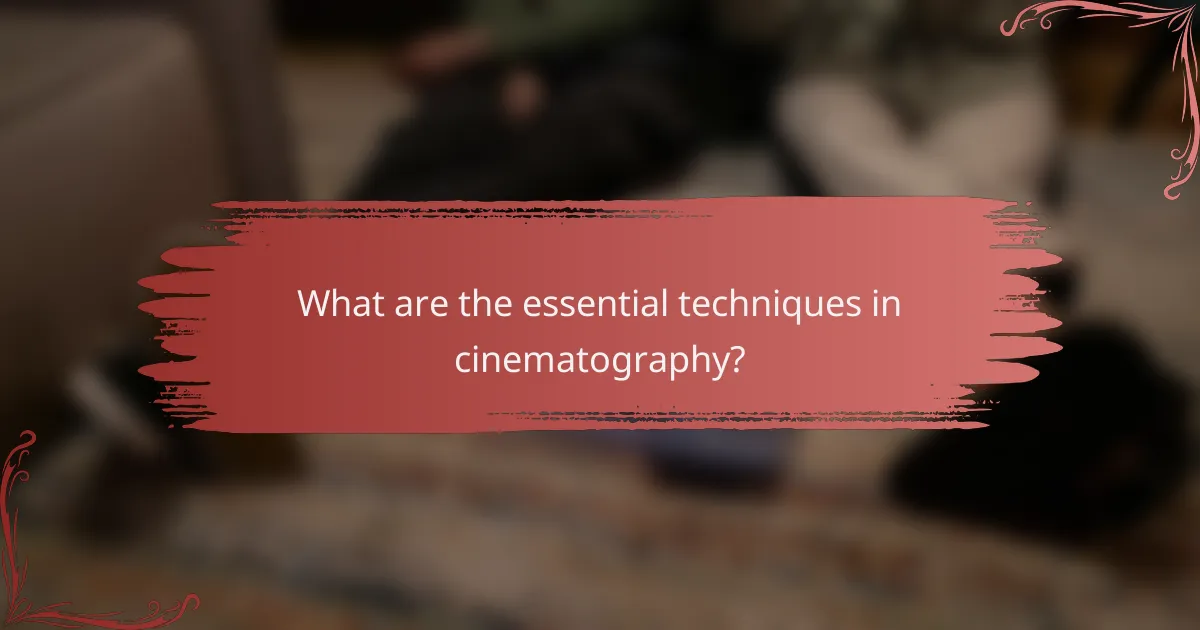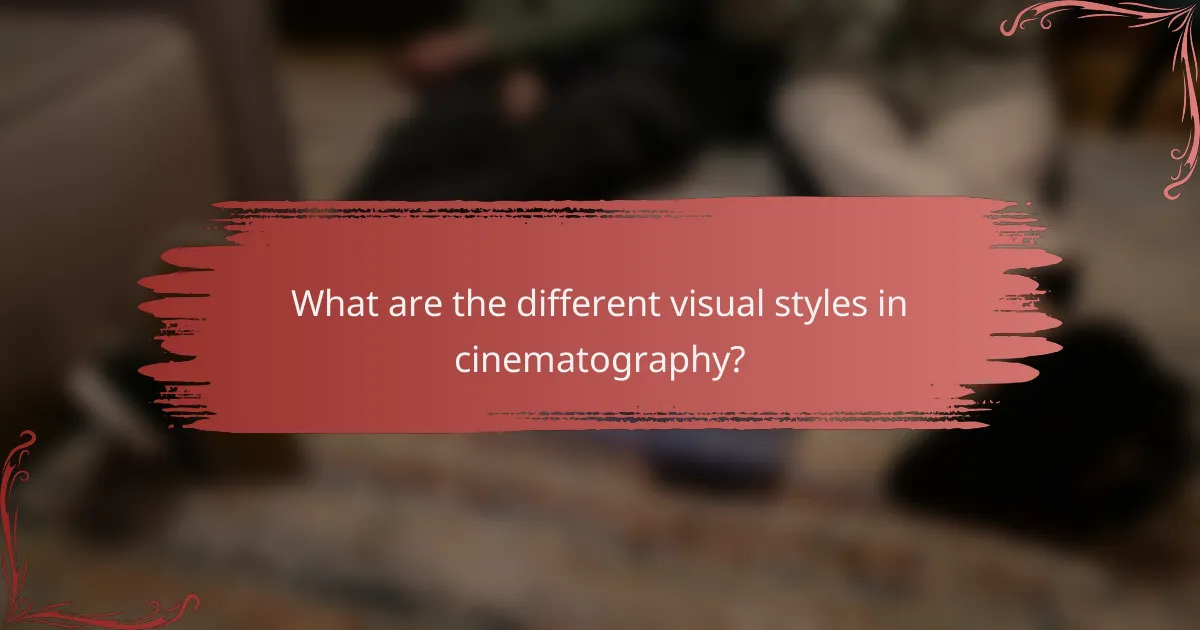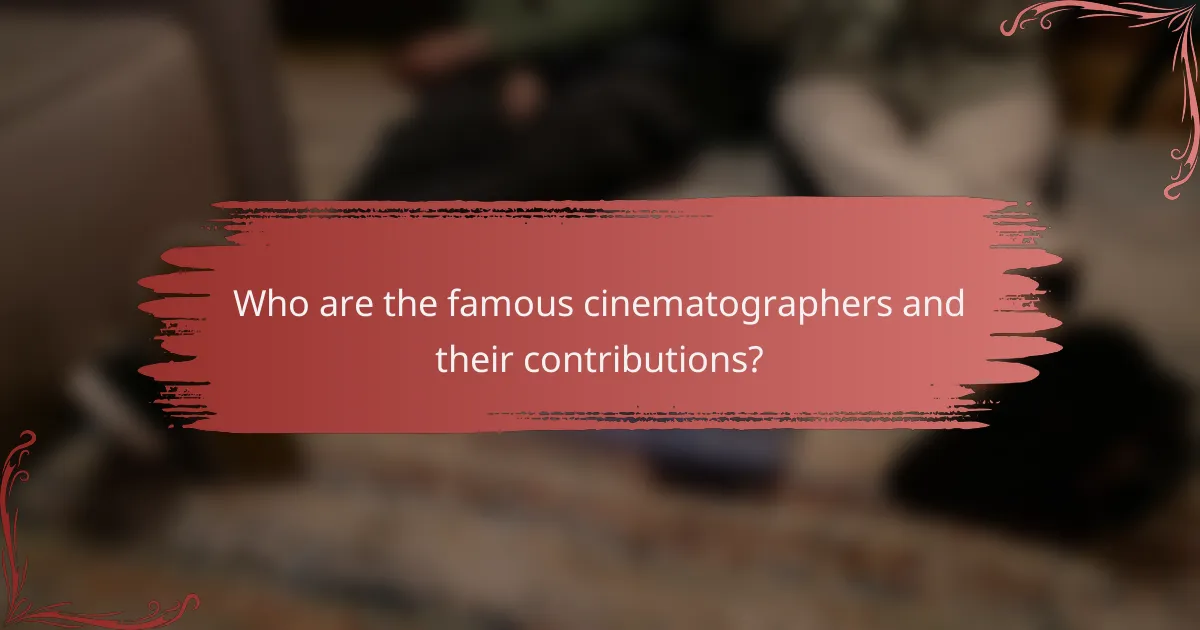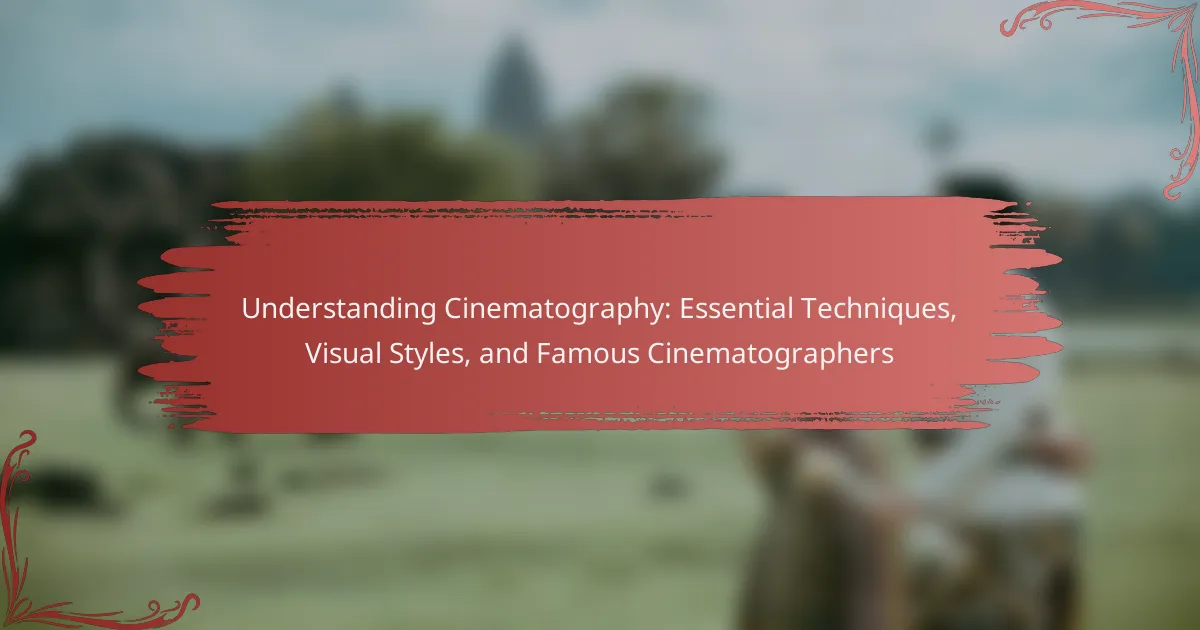Cinematography is the art and technique of capturing visual images for film and television, involving critical elements such as camera use, lighting, and composition. Key techniques include composition, lighting, camera movement, and shot selection, which are essential for creating compelling narratives. The article explores various visual styles in cinematography, including realism, expressionism, and surrealism, highlighting how each style influences storytelling. Additionally, it features renowned cinematographers like Roger Deakins, Emmanuel Lubezki, Vittorio Storaro, and Janusz Kamiński, showcasing their contributions to the field and their impact on visual aesthetics in cinema. Understanding these fundamental aspects of cinematography enhances the viewer’s experience and comprehension of film narratives.

What is Cinematography?
Cinematography is the art and technique of capturing visual images for film and television. It involves the use of cameras, lighting, and composition to create the desired aesthetic. Cinematographers, or directors of photography, make critical decisions on shot selection and camera movement. They also determine lighting, color grading, and lens choices to evoke specific emotions. The history of cinematography dates back to the late 19th century with pioneers like Thomas Edison and the Lumière brothers. Notable films have showcased innovative cinematography, influencing visual storytelling. Techniques such as depth of field, framing, and movement are essential in creating a compelling narrative. Cinematography plays a crucial role in enhancing the viewer’s experience and understanding of the story.
How does cinematography influence storytelling in film?
Cinematography significantly influences storytelling in film by shaping visual narrative elements. It determines how scenes are framed, which affects audience perception. Camera angles can evoke emotions and convey power dynamics. Lighting sets the mood and emphasizes themes. Color palettes can symbolize character arcs or emotional states. The choice of lenses alters depth and focus, guiding viewer attention. Movement, such as tracking shots, creates a sense of urgency or intimacy. Editing rhythm, influenced by cinematography, impacts the pacing of the story. Collectively, these techniques enhance the narrative and deepen audience engagement.
What are the key elements that define cinematography?
Cinematography is defined by key elements such as composition, lighting, camera movement, and color. Composition involves framing and arrangement of visual elements within a shot. It affects how viewers perceive the story. Lighting sets the mood and tone, influencing the emotional response. Camera movement includes techniques like pans, tilts, and tracking shots, which enhance storytelling. Color plays a vital role in conveying themes and emotions. Each of these elements works together to create a visual narrative. Historical examples include the use of chiaroscuro in film noir and vibrant colors in Technicolor films. These elements are essential for effective visual storytelling in cinema.
How do different cinematographic techniques enhance narrative?
Different cinematographic techniques enhance narrative by shaping the viewer’s emotional response and guiding their understanding of the story. Techniques such as camera angles influence perspective and character perception. For example, a low-angle shot can convey power or dominance, while a high-angle shot may suggest vulnerability. Lighting techniques set the mood and tone, impacting how scenes are interpreted. High-key lighting often creates a cheerful atmosphere, while low-key lighting can evoke tension or suspense.
Camera movement, like tracking shots, can immerse viewers in action and create a sense of urgency. Editing techniques, such as cross-cutting, allow simultaneous storytelling, enhancing dramatic tension. The use of color palettes can symbolize themes or character arcs, further deepening narrative layers. Historical examples, like the use of chiaroscuro in film noir, demonstrate how visual style directly supports storytelling. Thus, cinematographic techniques are essential for conveying complex narratives effectively.
Why is cinematography considered an art form?
Cinematography is considered an art form because it combines technical skill with creative expression. It involves the visual storytelling of a film through the use of camera angles, lighting, and composition. Each choice made by a cinematographer influences the audience’s emotional response. The visual aesthetics can convey themes and enhance narrative depth. Historical examples, like the work of Roger Deakins, showcase how cinematography shapes cinematic experiences. Techniques such as framing and color grading create distinct styles that resonate with viewers. Additionally, awards like the Academy Award for Best Cinematography recognize its artistic significance in filmmaking. Thus, cinematography is a vital component that elevates film to an art form.
What skills are essential for a cinematographer?
A cinematographer must possess technical proficiency in camera operation and lighting. They should understand composition and framing to create visually appealing shots. Knowledge of color theory is essential for achieving the desired mood. Familiarity with various camera equipment and lenses enhances their versatility. They need strong collaboration skills to work effectively with directors and crew. An understanding of visual storytelling is crucial for conveying narratives through imagery. Adaptability to different filming conditions and environments is also important. Continuous learning about new technologies and techniques keeps their skills relevant.
How does creativity play a role in cinematography?
Creativity is fundamental in cinematography as it shapes visual storytelling. Cinematographers use creative techniques to convey emotions and themes. They select camera angles, lighting, and composition to enhance narrative impact. For example, the use of color grading can evoke specific moods. Innovative shot framing can create unique perspectives. Creativity also drives the use of visual effects and transitions. Historical examples include the groundbreaking work of Roger Deakins in films like “Skyfall.” His creative choices significantly influenced the film’s visual style and audience engagement.

What are the essential techniques in cinematography?
Essential techniques in cinematography include composition, lighting, camera movement, and shot selection. Composition involves arranging visual elements to guide the viewer’s eye. Lighting sets the mood and highlights subjects, influencing emotional responses. Camera movement, such as pans or tilts, adds dynamism and perspective. Shot selection determines the framing and angles, affecting storytelling. These techniques are foundational in creating visually compelling narratives. For example, the rule of thirds is a common compositional technique that enhances visual interest. Understanding these techniques is crucial for effective visual storytelling in film and video production.
How do lighting techniques affect the mood of a scene?
Lighting techniques significantly influence the mood of a scene. Different lighting styles evoke various emotional responses. For example, high-key lighting creates a bright and cheerful atmosphere. Conversely, low-key lighting generates tension and drama through shadows. Soft lighting can produce a romantic or intimate feel. Harsh lighting often conveys discomfort or anxiety. Color temperature also plays a role; warm tones suggest comfort, while cool tones can imply sadness or isolation. Studies show that lighting impacts viewer perception, affecting emotional engagement. Thus, effective lighting is crucial in shaping the narrative and emotional landscape of a film.
What are the different types of lighting used in cinematography?
The different types of lighting used in cinematography include key lighting, fill lighting, backlighting, and practical lighting. Key lighting serves as the primary light source, illuminating the subject. Fill lighting softens shadows created by the key light, providing balance. Backlighting highlights the subject’s outline, creating depth and separation from the background. Practical lighting incorporates visible light sources within the scene, enhancing realism. Each type plays a crucial role in establishing mood and visual storytelling.
How can lighting be manipulated to create specific effects?
Lighting can be manipulated to create specific effects by adjusting intensity, color, and direction. Different intensities can evoke various moods; for example, low light creates a sense of mystery. Color temperature affects emotional perception; warm tones can feel inviting, while cool tones may seem sterile. Direction of light influences shadows and highlights, shaping the subject’s appearance. Using backlighting can create silhouettes, emphasizing outlines over details. Side lighting can enhance texture and depth, making surfaces appear more three-dimensional. Additionally, diffusion materials soften harsh light, creating a more flattering look. These techniques are essential in cinematography to convey storytelling visually.
What role does camera movement play in cinematography?
Camera movement is crucial in cinematography as it enhances storytelling and visual engagement. It can create emotional responses and guide audience focus. Techniques such as panning, tilting, and tracking provide dynamic perspectives. These movements can convey action, intimacy, or tension. For example, a tracking shot follows a character, immersing viewers in the scene. Studies show that intentional camera movement influences audience perception and emotional connection. Effective camera movement contributes significantly to the overall narrative and aesthetic of a film.
What are the various types of camera movements?
The various types of camera movements include panning, tilting, tracking, dolly, crane, and zooming. Panning involves moving the camera horizontally from a fixed position. Tilting refers to moving the camera vertically while remaining in one spot. Tracking, or trucking, involves moving the camera along with the subject. Dolly movements occur when the camera is placed on a wheeled platform and moved toward or away from a subject. Crane shots involve lifting the camera on a crane for sweeping views. Zooming changes the focal length of the lens to make subjects appear closer or further away. Each movement serves a specific purpose in storytelling and visual composition.
How do camera angles influence viewer perception?
Camera angles significantly influence viewer perception by altering how scenes are interpreted. Different angles can evoke various emotional responses. For example, a low-angle shot can make a subject appear powerful or imposing. Conversely, a high-angle shot may render a subject vulnerable or submissive.
Research indicates that these angles directly affect audience engagement. A study by the University of Southern California found that low-angle shots increased feelings of dominance in viewers. Additionally, camera angles can shape narrative focus. Close-ups draw attention to specific emotions, while wide shots provide context.
Overall, camera angles serve as a visual language that communicates meaning beyond dialogue. Their strategic use can manipulate viewer perception and emotional response effectively.

What are the different visual styles in cinematography?
Different visual styles in cinematography include realism, expressionism, and surrealism. Realism aims to depict life accurately and authentically. It often uses natural lighting and handheld camera work. Expressionism emphasizes emotional experience over physical reality. It employs exaggerated visuals and dramatic lighting. Surrealism blends reality with dream-like elements. It often features unconventional narratives and imagery. Other styles include documentary, which captures real events, and noir, characterized by high contrast and shadow. Each style influences the mood and storytelling of a film.
How do visual styles contribute to a film’s identity?
Visual styles significantly shape a film’s identity. They encompass elements like color palettes, lighting, and camera angles. These visual choices create a distinct atmosphere. For instance, a dark color scheme may evoke tension. In contrast, bright colors can convey joy or whimsy. The consistency of visual styles reinforces thematic elements. Iconic films often have recognizable visual signatures. For example, Wes Anderson is known for his symmetrical compositions and pastel colors. Such styles become synonymous with the filmmaker’s brand. Ultimately, visual styles are crucial in establishing a film’s unique voice and emotional impact.
What are some common visual styles used in cinematography?
Common visual styles used in cinematography include realism, expressionism, and documentary. Realism aims to depict life accurately, often using natural lighting and unembellished settings. Expressionism emphasizes emotional experience, utilizing exaggerated visuals and stylized lighting. Documentary style focuses on capturing real events, usually with handheld cameras and minimal staging. Other styles include noir, characterized by high contrast and shadows, and surrealism, which blends dreamlike imagery with reality. Each visual style serves to convey specific themes and emotions, enhancing the storytelling experience in film.
How do visual styles evolve over time in the film industry?
Visual styles in the film industry evolve through technological advancements, cultural shifts, and artistic movements. The introduction of sound in the late 1920s transformed visual storytelling. The 1960s saw a shift towards more experimental techniques, influenced by the counterculture movement. The advent of digital technology in the 2000s revolutionized visual effects and cinematography. Directors and cinematographers increasingly explore unique aesthetics, such as the use of color grading and unconventional framing. Each era reflects societal values and technological capabilities, influencing how stories are visually represented. For example, the rise of streaming platforms has led to diverse visual styles in contemporary cinema.
What are the characteristics of contemporary cinematographic trends?
Contemporary cinematographic trends are characterized by advancements in technology and innovative storytelling techniques. Digital cinematography has largely replaced traditional film, allowing for greater flexibility and efficiency. High dynamic range (HDR) imaging enhances visual detail and color accuracy. Additionally, the use of drones and gimbals has transformed aerial and dynamic shots.
Furthermore, non-linear narratives are increasingly popular, providing unique storytelling experiences. The integration of virtual reality (VR) and augmented reality (AR) is becoming more prevalent in filmmaking. Diverse representation in casting and storytelling is emphasized to reflect global audiences. Lastly, streaming platforms influence cinematographic styles, prioritizing shorter formats and binge-worthy content.
How do technological advancements shape visual styles?
Technological advancements significantly shape visual styles in cinematography. Innovations in camera technology allow for higher resolution and improved image quality. For instance, the transition from film to digital cameras has transformed how filmmakers capture scenes. Digital cameras provide greater flexibility in editing and post-production. Advances in software for visual effects enable more creative storytelling. Techniques such as CGI have expanded the possibilities for visual effects in films. Furthermore, the development of drones has introduced new perspectives in cinematography. These changes have influenced the aesthetic choices filmmakers make. Overall, technology continually evolves visual styles in the film industry.
What are the influences of digital cinematography on visual aesthetics?
Digital cinematography significantly influences visual aesthetics by enhancing image quality and flexibility. It allows for higher resolution and dynamic range, resulting in more vivid colors and detailed textures. Digital sensors can capture a wider spectrum of light compared to traditional film. This capability enables filmmakers to achieve unique visual styles and effects.
Moreover, digital tools facilitate real-time monitoring and adjustments during shooting. This immediacy allows for creative experimentation that can shape the final aesthetic. The use of digital editing software further enhances post-production possibilities. Filmmakers can manipulate color grading and visual effects seamlessly.
For instance, films like “The Social Network” and “Mad Max: Fury Road” showcase how digital cinematography can create distinct visual narratives. These films utilize digital techniques to enhance storytelling through their visual styles. Overall, digital cinematography has transformed visual aesthetics by providing new creative avenues and technical advantages.

Who are the famous cinematographers and their contributions?
Roger Deakins is a renowned cinematographer known for his work on films like “Skyfall” and “1917.” His contributions include innovative lighting techniques and a mastery of visual storytelling. Emmanuel Lubezki, another famous cinematographer, is celebrated for his work on “Birdman” and “The Revenant.” He is known for his use of natural light and long takes. Vittorio Storaro is recognized for his color theory and composition in films such as “Apocalypse Now” and “The Last Emperor.” His work has influenced the visual aesthetics of cinema. Janusz Kamiński is notable for his collaboration with Steven Spielberg on films like “Schindler’s List” and “Saving Private Ryan.” His contributions include dynamic camera movements and rich visual narratives.
What impact have renowned cinematographers had on the film industry?
Renowned cinematographers have significantly shaped the film industry. They influence visual storytelling through innovative techniques. Their work enhances the emotional impact of films. Cinematographers like Roger Deakins and Emmanuel Lubezki are known for their unique styles. Deakins’ use of natural lighting creates realism. Lubezki’s long takes immerse viewers in the narrative. Their contributions have set new standards in cinematography. Awards such as the Academy Award recognize their achievements. This recognition highlights the importance of cinematography in filmmaking.
Who are some of the most influential cinematographers in history?
Some of the most influential cinematographers in history include Roger Deakins, Vittorio Storaro, and Emmanuel Lubezki. Roger Deakins is known for his work on films like “Skyfall” and “1917.” He has received multiple Academy Awards for his cinematography. Vittorio Storaro is famous for his collaboration with directors like Bernardo Bertolucci on “The Last Emperor.” His use of color and light has shaped modern cinematography. Emmanuel Lubezki, known as “Chivo,” has won three consecutive Oscars for films such as “Gravity” and “Birdman.” His innovative techniques in natural lighting have set new standards in the industry. These cinematographers have significantly impacted visual storytelling in cinema.
What signature techniques are associated with these cinematographers?
It is not possible to answer the question as it lacks specificity regarding which cinematographers are being referenced. Without identifying the cinematographers, signature techniques cannot be accurately described.
How do famous cinematographers inspire new generations?
Famous cinematographers inspire new generations through their innovative techniques and visual storytelling. Their work showcases the power of visual imagery in film. For instance, Roger Deakins has influenced many with his mastery of light and shadow. His collaboration on films like “Blade Runner 2049” demonstrates how cinematography can enhance narrative depth. Similarly, Emmanuel Lubezki’s long takes in “Birdman” inspire aspiring filmmakers to experiment with continuity and movement. These cinematographers often share insights through interviews and masterclasses. Their artistic choices serve as a reference point for students and professionals alike. By pushing creative boundaries, they motivate new talent to explore their own unique styles.
What can aspiring cinematographers learn from their work?
Aspiring cinematographers can learn technical skills and creative techniques from their work. They gain proficiency in camera operation, lighting, and composition. Understanding these elements enhances their storytelling abilities. They also learn to collaborate with directors and other crew members effectively. This teamwork is essential for executing a shared vision. Additionally, they develop problem-solving skills in dynamic shooting environments. Experience teaches them to adapt to challenges on set. Learning from feedback helps refine their artistic style. Ultimately, practical experience is crucial for growth in cinematography.
How do mentorship and collaboration shape a cinematographer’s career?
Mentorship and collaboration significantly shape a cinematographer’s career by providing guidance and networking opportunities. Mentorship offers insights from experienced professionals, enhancing technical skills and artistic vision. Collaboration with directors, producers, and other crew members fosters creativity and innovation in projects. This teamwork can lead to diverse experiences and exposure to various filmmaking styles. Studies show that strong professional networks increase job opportunities in the film industry. Successful cinematographers often credit mentors for pivotal career advancements and learning experiences.
What are some practical tips for aspiring cinematographers?
Aspiring cinematographers should focus on mastering the fundamentals of camera operation. Understanding exposure, composition, and lighting is crucial. Practice using different camera settings to see their effects. Experiment with various lenses to grasp their unique characteristics. Study films critically to analyze cinematographic techniques. Networking with industry professionals can provide valuable insights and opportunities. Building a diverse portfolio showcases versatility and skill. Continuous learning through workshops and online courses enhances knowledge and expertise.
How can one develop a unique cinematographic style?
To develop a unique cinematographic style, one must first study various visual styles. Understanding different techniques enhances creativity. Experimentation with lighting, camera angles, and color palettes is crucial. This process allows for the discovery of personal preferences. Analyzing the works of influential cinematographers provides valuable insights. Practicing consistently helps refine skills and establish a signature look. Engaging with feedback from peers fosters growth and innovation. Documenting the creative process aids in identifying patterns and themes that resonate personally.
What resources are available for learning cinematography techniques?
Books, online courses, and workshops are key resources for learning cinematography techniques. Notable books include “Cinematography: Theory and Practice” by Blain Brown. Online platforms like MasterClass and Coursera offer courses from industry professionals. Workshops provide hands-on experience and networking opportunities. Websites like No Film School and American Cinematographer feature articles and tutorials. These resources collectively cover theory, practical skills, and industry insights.
Cinematography is the art and technique of capturing visual images for film and television, involving critical elements such as composition, lighting, camera movement, and color. This article explores how cinematography influences storytelling, enhances narratives through various techniques, and is recognized as an art form. It also examines essential skills for cinematographers, the impact of technological advancements on visual styles, and highlights renowned cinematographers and their contributions to the film industry. By understanding these aspects, readers will gain insights into the foundational principles and evolving trends in cinematography.
